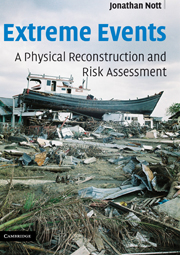4 - Tropical cyclones
Published online by Cambridge University Press: 18 December 2009
Summary
Formation of tropical cyclones
Tropical cyclones form over tropical seas and oceans where the sea surface temperature is at least 27 °C. They are low pressure systems that develop a warm core or eye structure which is an area of subsiding air in the centre of the system. Around and towards the eye, air spirals inwards and upwards from the outer parts of the cyclone with the area of maximum uplift occurring adjacent to the eye. As the air converges inward, it is deflected to the left (clockwise) in the southern hemisphere and to the right (anticlockwise) in the northern hemisphere due to the Coriolis effect. The wind velocity increases towards the eye, approximately doubling as the distance from the eye is halved. This does not mean that larger diameter cyclones necessarily have stronger winds as the wind velocity is also dependent on the pressure gradient across the system with lower central pressures usually having a stronger pressure gradient.
Tropical cyclones can be likened to a thermodynamic heat engine where energy, due to evaporation from the ocean surface, is lost via thermal radiation after the air rises and diverges between 12 and 15 km altitude (Holland and McBride, 1997). If the air is allowed to continue to rise and diverge at the top of the troposphere (lower layer of the Earth's atmosphere) then air will continue to be drawn into the centre of the system and the tropical cyclone will intensify. There is a limit to this intensification.
- Type
- Chapter
- Information
- Extreme EventsA Physical Reconstruction and Risk Assessment, pp. 77 - 108Publisher: Cambridge University PressPrint publication year: 2006



